Practicing the CBSE Sample Papers for Class 12 Biology with Solutions Set 3 allows you to get rid of exam fear and be confident to appear for the exam.
CBSE Sample Papers for Class 12 Biology Set 3 with Solutions
Time: 3 Hours.
Max. Marks: 70
General Instructions:
- All questions are compulsory.
- The question paper has five sections and 33 questions. All questions are compulsory.
- Section-A has 16 questions of 1 mark each; Section- B has 5 questions of 2 marks each; Section- C has 7 questions of 3 marks each; Section- D has 2 case-based questions of A marks each; and Section- E has 3 questions of 5 marks each.
- There is no overall choice. However, internal choices have been provided in some questions. A student has to attempt only one of the alternatives in such questions.
- Wherever necessary, neat and properly labeled diagrams should be drawn.
Section – A (16 Marks)
Question 1.
Among the terms listed below, those that of are not technically correct names for a floral whorl are: [1]
(i) Androecium
(ii) Carpel
(iii) Corolla
(iv) Sepal
(a) (i) and (iv)
(b) (iii) and (iv)
(c) (ii) and (iv)
(d) (i) and (ii)
Answer:
(c) (ii) and (iv)
Explanation: The technically correct terms for the floral whorls are (from outermost to innermost) calyx, corolla, androecium and gynoecium. They are made up of sepals, petals, stamens and carpels respectively.
Question 2.
Match the contraceptive methods given under column I with their examples given under column II and select the correct option. [1]
|
Column I(Contraceptive methods) |
Column II (Examples) | ||
| A | Barriers | (i) | Tubectomy and vasectomy |
| B | IUDs | (ii) | Spermicidal jelly and foam |
| C | Chemical | (iii) | Vaults and cervical cap |
| D | Sterilisation | (iv) | Multiload 375 |
(a) A-(ii), B-(iv), C-(i), D-(iii)
(b) A-(iii), B-(iv), C-(i), D-(ii)
(c) A-(iii), B-(iv), C-(ii), D-(i)
(d) A-(ii), B-(i), C-(iii), D-(iv)
Answer:
(c) A-(iii), B-(iv), C-(ii), D-(i)
Explanation: Spermicidal jelly and foam are the chemical forms of birth control. IUDs are Intrauterine devices that are placed in the uterine cavity. This consists of the copper-T and loop.
Condom and cervical cap are mechanical barriers. Tubectomy and vasectomy are surgical methods. These methods are permanent forms of birth control.
Question 3.
Given diagram represents the schematic structure of a transcription unit with some parts labelled as A, B, C, and D. Select the option which shows its correct labelling. [1]

| A | B | C | D | |
| (a) | Terminator | Template strand | Coding strand | Promoter |
| (b) . | Promoter | Coding strand | Template strand | Terminator |
| (c) | Terminator | Coding strand | Template strand | Promoter |
| (d) | Promoter | Template strand | Coding strand | Terminator |
Answer:
| A | B | C | D | |
| (d) | Promoter | Template strand | Coding strand | Terminator |
Explanation: The segment of DNA that takes part in transcription is called transcription unit. It has three components. Promoter is located upstream of structural gene. It is called 5’ end of coding strand which is 3’ end of template strand. Terminator region is present downstream of structural gene at the 3’ end of coding strand which is actually 5′ end of the template strand.
Question 4.
Wings of pigeon, bat and mosquito exhibit the phenomenon called. [1]
(a) Convergent evolution
(b) Divergent evolution
(c) Atavism
(d) All of the above
Answer:
(a) Convergent evolution
Explanation: Convergent evolution is defined as the process whereby distantly related organisms independently evolve similar traits to adapt to similar necessities. Pigeon, bat and mosquito all use their wings for flying but their origin or structure is different.
Question 5.
Which of the following statements is incorrect regarding Yogurt? [1]
(a) It is fermented milk.
(b) Mixed with an inoculum containing Streptococcusfaecalis.
(c) Preparation takes approximately 4-5 hours.
(d) The original flavour of yogurt is of acetaldehyde.
Answer:
(b) Mixed with an inoculum containing Streptococcus faecalis
Explanation: Yogurt is fermented milk. The milk is heated to 80-90°C for half an hour and then it is cooled to 40-43°C and mixed with an inoculum containing Streptococcus. Preparation of Yogurt takes approximately 4-5 hours. The original flavour of Yogurt is of acetaldehyde.
![]()
Question 6.
The organisms which cause diseases in plants and animals are called: [1]
(a) pathogens
(b) vectors
(c) insects
(d) worms
Answer:
(a) pathog
Explanation: A wide range of organisms including bacteria, viruses, fungi, protozoans, helminths, etc., cause diseases in plants and animals. Such disease causing organisms are called pathogens. While vectors are the carriers of pathogens which may be insects or worms.
Question 7.
Identify the likely organism (1), (2), (3) and (4) in the food web shown below: [1]
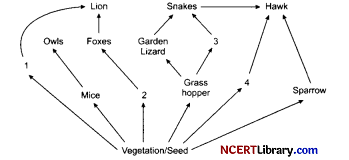
| (1) | (2) | (3) | (4) | |
| (a) | deer | rabbit | frog | rat |
| (b) | dog | squirrel | bat | deer |
| (c) | rat | dog | tortoise | crow |
| (d) | squirrel | cat | rat | pigeon |
Ans.
| (b) | deer | rabbit | frog | rat |
Explanation: Deer is prey to lion. Rabbit is prey to foxes. Snake eats a frog. Hawk preys to rat. So, option (a) is correct.
Question 8.
What is the first sign or symptom of tetanus? [1]
(a) Stiffness of neck
(b) Swelling in neck
(c) Paralysis
(d) Numbness in fingers
Answer:
(a) Stiffness of neck
Explanation: Stiffness of neck is the first symptom of tetanus. Then there is difficulty in swallowing and chewing. Subsequently, spasms of muscles of the jaw and face take place. There is severe pain. It is often a fatal disease.
Question 9.
Population density for a particular area can be calculated by: [1]
(a) \(D=\frac{N}{S}\)
(b) S = N x D
(c) D = S x N
(d)\(N=\frac{S}{D}\)
Explanation: The formula for finding the population density is D = N/S or population density = a number of organisms/area.
Question 10.
Both hydrarch and xerarch successions lead to: [1]
(a) medium water conditions
(b) xeric conditions
(c) highly dry conditions
(d) excessive wet conditions
Answer:
(a) medium water conditions
Explanation: Both Hydrarch and Xerarch succession lead to medium water conditions. Xerarch succession takes place in dry areas and the series progress from xeric to mesic (medium water) condition.
Question 11.
Match the following columns of bacteria and their commercially important products. [1]
| Column I (Bacterium) | Column II (Product) |
| A. Aspergilus niger | 1. Lactic acid |
| B. Acetobacter aceti | 2. Butyric acid |
| C. Clostridium butylicum | 3. Acetic acid |
| D. Lactobacillus | 4. Citric acid |
| A | B | C | D | |
| (a) | 2 | 3 | 4 | 1 |
| (b) | 2 | 4 | 3 | 1 |
| (c) | 4 | 3 | 2 | 1 |
| (d) | 4 | 1 | 3 | 2 |
Answer:
| (c) | 4 | 3 | 2 | 1 |
Explanation: Following is the list of bacteria and their commercially important products.
![]()
Question 12.
A person with sickle-cell anaemia is: [1]
(a) More prone is malaria
(b) More prone to typhoid
(c) Less prone to malaria
(d) Less prone to typhoid
Answer:
(c) Less prone to malaria
Explanation: Sickle-cell anaemia is related to malaria, not to typhoid and person suffering from sickle cell anaemia arc resistant to malarial parasite as RBCs of sickle-cell anaemic patients is distorted in shape and is not affected by Plasmodium sp.
Question No. 13 to 16 consist of two statements – Assertion (A) and Reason (R). Answer these questions selecting the appropriate option given below:
(a) Both A and R are true and R is the correct explanation of A.
(b) Both A and R are true and R is not the correct explanation of A.
(c) A is true but R is false.
(d) A is false but R is true.
Question 13.
Assertion: The bulbourethral gland is a male accessory gland. [1]
Reason: The secretions of bulbourethral glands helps in the lubrication of the penis.
Answer:
(b) Both A and R are true and R is not the correct explanation of A.
Explanation: The accessory glands of the male reproductive system are the seminal vesicles, prostate gland, and the bulbourethral glands. Bulbourethral glands also known as Cowper glands, provide mucus that lubricates the urethra and counteracts the acidity of any urine leftover in the urethra. Thus, both assertion and reason are true but reason is not the correct explanationof the assertion.
Question 14.
Assertion: In codominance, FI generation resembles both the parents. [1]
Reason: An example is different type of red blood cells that determine ABO blood grouping in humans.
Answer:
(b) Both A and R are true but R is not the correct explanation of A.
Explanation: ABO blood group system is an example of multiple alleles. Also, the presence of A and B alleles give rise to the AB blood group and is codominant. There are 3 alleles for the gene that determines blood type. Thus both assertion and reason are true but reason is not the correct explanation of the assertion.
Question 15.
Assertion: All immunoglobin molecules have a basic structure composed of four polypeptide chains. [1]
Reason: The polypeptide chains consist of two identical heavy and light chains connected by disulphide bonds.
Answer:
(b) Both A and R are true and R is not the correct explanation of A.
Explanation: In the structure of Immunoglobulin, two heavy and light chains are present and connected by disulphide linkages. Thus, both assertion and reason are true but reason is not the correct explanation of the assertion.
![]()
Question 16.
Plasmodium falciparum enters the human body as sporozoites (infectious form) through the bite of infected female Anopheles mosquito. The parasites initially multiply within the liver cells and then attack the red blood cells (RBCs) resulting in their rupture.
The rupture of RBCs is associated with release of a toxic substance, haemozoin, which is responsible for the chill and high fever recurring every three to four days, is the most serious one and can even be fatal. Now study the passage and comment upon the appropriateness of the assertion and reason.
Assertion: In malaria, a person experiences chills and high fever recurring every three to four days.
Reason: This is caused by the release of haemozoin with rupture of liver cells. [1]
Answer:
(c) A is true but R is false.
Explanation: In Malignant malaria caused by Plasmodiumfalciparum is the most serious one and can even be fatal. The parasites initially multiply within the liver cells and then attack the red blood cells (RBCs) resulting in their rupture. The rupture of RBCs is associated with the chill and high fever recurring every three to four days. Thus, assertion is true but reason is false.
Section – B (10 Marks)
Question 17.
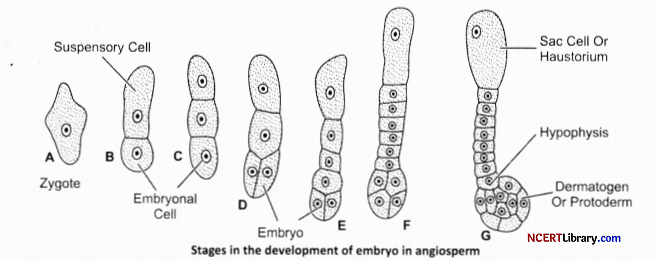
(a) Describe the term double fertilization in angiosperms.
(b) What are the end products of double fertilization? [2]
Answer:
(a) Double fertilization is a complex process where out of two sperm cells, one fuses with the egg cell and the other fuses with two polar nuclei which result in a diploid (2n) zygote and a triploid (3n) primary endosperm nucleus (PEN) respectively.
(b) The end products of double fertilization are:
(i) Diploid Zygote
(ii) Primary Endosperm Nucleus
Question 18.
Why is pedigree analysis done for the study of human genetics? State the conclusions that can be drawn from it. [2]
Answer:
Pedigree analysis is done for the study of human genetics because:
(a) Controlled crosses are not possible in case of human beings.
(b) Analysis of traits in several generations of a family.
So, as to trace the pattern of inheritance the pedigree analysis is used to identify whether the trait is sex linked or not and dominant or recessive.
Question 19.
Cancer is one of the most dreaded diseases of humans Explain ‘Contact inhibition’ and ‘Metastasis’ with respect to disease. Name the groups of genes which have been identified in the normal cells that could lead to cancer and how they do so?
Name any two techniques which are useful to detect cancers of internal organs Why are cancer patients often given alpha interferon as part of the treatment? [2]
Answer:
Contact inhibition refers to the phenomenon by which, the contact with other cells inhibits the uncontrolled growth of the cancerous cells. Metastasis is when the tumour cells reach the distant organs site through the blood.
The group of gene is oncogenes. When activated under certain conditions there is oncogenic transformation of cells. The techniques to detect cancers are Biopsy, Radiography, CT and MRI through which the presence of cancer can be detected. The alpha interferon activates the immune system and destroys the tumours, so it is given to the cancer patients as the part of the treatment.
Question 20.
Study the diagram given below and answer the question asked in relation with it? [2]

(a) What role does the acid-base inlet play?
(b) Name another type of bioreactor used commercially?
Answer:
(a) The acid-base inlet enables to control the pH of the mixture in the bioreactor vessel.
(b) Another such type of bioreactor is sparged stirred-tank bioreactor through which the sterile air bubbling is done.
![]()
Question 21.
(a) What depicts the difference in population size between time 2 and time 3. The population size of a species over time is show in the graph. [2]
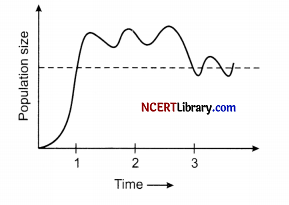
(b) In short, explain about the exponential growth of population.
OR
(a) How many primary producers do you think would be needed to support six tertiary consumers in a grassland ecosystem?
(b) Draw a grassland pyramid to substantiate your answer.
Answer:
(a) Decline in available food resources. As the population size decreases between 2 and 3 time there must be decline in available food which results in decline in size of population between 2 and 3 time.
(b) It is one of the growth models that explain the pattern of growth within the population. The model states that, if a population has a constant birth rate through time, and is never limited by availability of food and disease outbreak, then the population tends to grow exponentially. Through an exponential growth the birth rate alone determines the rate of growth as fast or slow.
OR
(a) 12,000,000
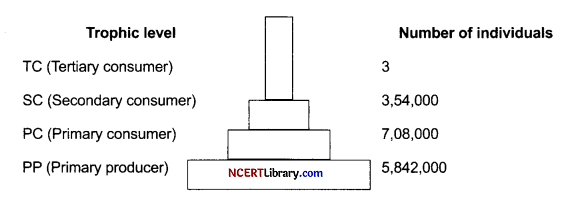
Section – C (21 Marks)
Question 22.
(a) Name the organic material exine of the pollen grain is made up of. How is this material advantageous to pollen grain?
(b) Still it is observed that it does not form a continuous layer around the pollen grain. Give reason.
(c) How are ‘pollen banks’ useful? [3]
Answer:
(a) The hard outer layer called exine is made up of sporopollenin which is one of the most resistant organic material. It can withstand high temperature, strong acids and alkalis. It cannot be degraded by any of the known enzymes. Hence, it acts as a shield and protects the pollen grain from getting damaged.
(b) Exine does not form a continuous layer around the pollen grain. Exine of the pollen grain has prominent aperture called germ pore where sporopollenin is absent. Germ pores serve as an outlet for the formation of pollen tube.
(c) Pollen grains at a large can be stored for years in liquid nitrogen (- 196BC). So, after this treatment they are stored in pollen banks. Such conserved pollen grains can be used in plant breeding programs.
Question 23.
Write the specific location and the functions of the following cell in human male: [3]
(a) Leydig cells
(b) Sertoli cells
(c) Primary spermatocyte
Answer:
(a) Leydig cell are situated outside seminiferous tubules in the interstitial space. They synthesise or secrete male hormones.
(b) Sertoli cells are lined inside the seminiferous tubules. They play a role in providing the nutrition to the sperms.
(c) Primary spermatocyte are found in the testes in a structure known as the seminiferous tubules. They are diploid (2m) cells containing 46 chromosomes. After meiosis, two secondary spermatocytes are formed.
![]()
Question 24.
Analyse the diagram given below and answer the questions based on it: [3]
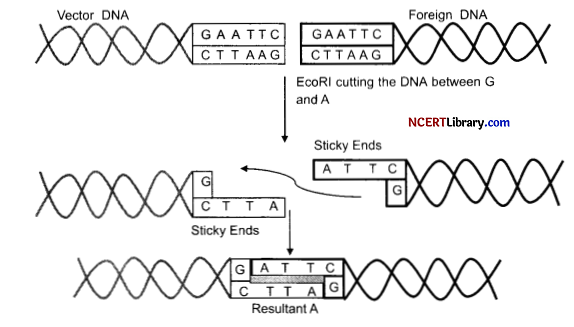
(a) After the entire process shown in the above diagram, what is resultant A?
(b) EcoRI cuts the DNA between the bases. What does EcoRI stand for?
(c) What are sticky ends?
Answer:
(a) The above diagram shows the action of restriction endonuclease and thus forms a recombinant DNA after completion of entire process.
(b) Eco stands for Escherichia coli, R stands for the name of the strain and Roman I indicates the order in which the enzymes were isolated from the strains of the bacteria.
(c) They are the resultant of hydrogen bonding that act as the site for attachment for the separated DNA fragments and facilitate the action of enzyme called DNA ligase.
Question 25.
(a) One of the salient features of the genetic code is that it is nearly universal from bacteria to humans. Mention two exceptions to this rule. Why are some codes said to be degenerate? [3]
(b) Following are the features of genetic codes. What does each one indicate? Stop codon; Unambiguous codon; Degenerate codon; Universal codon.
Answer:
(a) The two exceptions are presence of mitochondrial codons and it is absent in some protozoans Since, some amino acids are coded by more than one codon therefore they are said to be degenerate.
(b) (i) Stop Codon: They do not code for any amino acids and terminate the synthesis of polypeptide chain.
(ii) Unambiguous Codon: One codon codes for only one amino acid.
(iii) Degenerate Codon: Some amino acids are coded by more than one codon.
(iv) Universal Codon: It is same for all organisms (either bacteria or human).
Question 26.
Describe the structure and function of a t-RNA molecule. Why is it referred to as an adapter molecule? Also explain the process of splicing of hn-RNA in a eukaryotic cell. [3]
OR
(a) Why is DNA replication said to be semiconservative? Name the stage in the cell cycle where DNA replication occurs.
(b) Explain the mechanism of DNA replication. Highlight the role of enzymes in the process.
Answer:
f-RNA has clover leaf shape or the shape of an inverted L. It has an anticodon loop with bases which are complementary to a specific codon. It has an amino acid acceptor end. As it reads the code on one hand and binds with the specific amino acid on the other hand, it is referred to as an adapter molecule.
The hn-RNA in a eukaryotic cell is subjected to a process called splicing where the introns are removed and the exons are joined in a defined order.
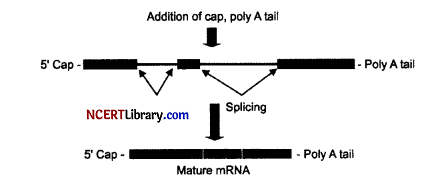
(a) DNA replication is semi-conservative because each helix that is created, contains one strand from the helix from which it was copied. The replication of one helix results in two daughter helices each of which contains one of the original parental helical strands. During S-Phase (Synthesis phase), DNA replicates in cell cycle.
(b) Mechanism of DNA replication: The interwined DNA strands start separating from a particular point called origin of replication (single in prokaryotes and many in eukaryotes). This unwinding is catalyzed by enzyme called Helicases. Enzymes called Topoisomerases break and reseal one of the strands of DNA so that the unwound strands will not wind back.
When the double stranded DNA is unwounded upto Replication Fork, enzyme DNA dependent DNA polymerase catalyses the joining of Deoxyribonucleotide (A, G, C and T) in the 5-3′ direction. The enzyme forms one new strand in a continuous stretch (leading strand) in the 5′-3′ direction on one of the template strands.
On the other template strand, the enzyme forms short stretches (discontinuous) strand of DNA also in the 5′-3′. The discontinuous fragments are later joined by DNA-ligase. The two strands are held together by hydrogen bonds between nucleotides.
![]()
Question 27.
The techniques shown in the given figure was adopted by some company for the production of recombinant human insulin. Observe the diagram and answer the following questions. [3]
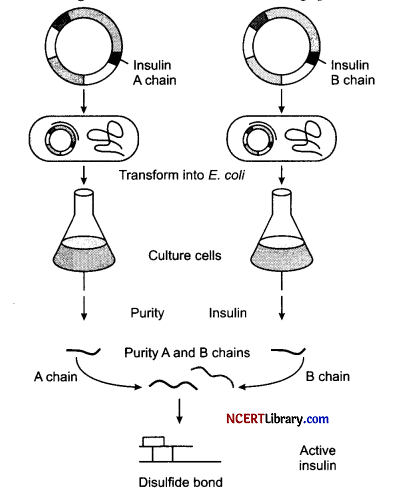
(a) How this technique was developed?
(b) All the 3 peptide chains were effectively working. Is this statement true or false? Explain.
Answer:
(a) This technique was developed by an American company. Eli Lilly an American company, prepared two DNA sequences corresponding to A and B chains of human insulin and introduced them in plasmids of two different E.coli to produce insulin chains separately and joined them later to get an active Insulin.
(b) No, this statement is false. The two chains A peptide and B peptide are joined by disulfide bond and C peptide is prohormone which is continously removed for formation of active insulin.
Question 28.
(a) What was the major challenge during production of insulin? [3]
(b) State the role of C-peptide in human insulin.
Answer:
(a) During production of insulin by rDNA technique, the major challenge was to get the assembled insulin into mature form.
(b) Presence of C-peptide makes the insulin inactive.
Section – D (8 Marks)
Questions No. 29 and 30 are case based questions. Each question has subparts with internal choice in one subpart.
Question 29.
Analyse the diagram and answer the question based on it: [4]
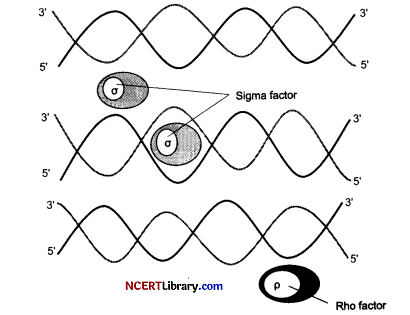
(a) How does the process of Transcription proceeds?
(b) What is termination of transcription?
(c) Which entity is responsible for initiation and termination of transcription?
OR
(c) Transcription and translation can be coupled in bacteria. Justify this statement.
Answer:
(a) The process proceeds from Initiation to elongation and from elongation to termination.
(b) It is the end process of transcription. When the polymerases reach the region of termination, the nascent RNA falls off along with RNA polymerase. This stage is a termination stage.
(c) The initiation factor (CT) is responsible for initiation whereas, termination factor (p) is responsible for termination of the transcription.
OR
(c) The process of transcription and translation occurs in the same compartment. Also, the process of translation begins much earlier before mRNA fully gets transcribed. Hence due to their occurrence, they can be coupled in the bacteria.
![]()
Question 30.
Analyse the diagram given below and answer the questions based on it. [4]
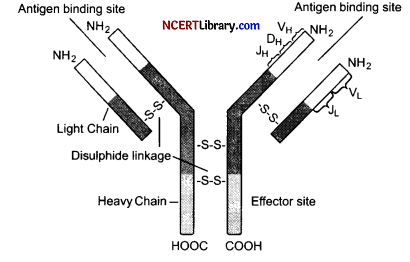
(a) Why is an antibody designated as H2L2?
(b) What is humoral immune response?
(c) Give the functions of IgA, IgM, IgE and IgG.
OR
(c) What are antibodies?
Answer:
(a) Each antibody molecule consists of two shorter chains called light chains and two longer chains called heavy chains. So to represent the number of chains it is designated as H2L2.
(b) It is the response given by the antibodies that are found in blood, such responses are called Humoral Immune Response.
(c) The functions are as follows:
(i) IgA: The Immunoglobulin A is a neutralizing antibody that acts as the first line of defence against mucosal pathogens. It gets attached to the epithelial surfaces and prevents the invasion of pathogens. It comprises about 10 to 15 % of the total antibodies present in the body.
(ii) IgM: It functions in production of B-cells. It is the first antibody to appear in response to the exposure of an antigen. It appears in the early course of infection and can reappear from time to time as per the growth of infection. It is also responsible for reactions of blood transfusion in ABO blood system.
(iii) IgE: This specific antibody is found in lungs, skin and mucous membrane that travels to the cell and releases the chemicals causing allergic reactions.
(iv) IgG: This immunoglobulin is responsible for deciding the Rh-factor of the blood. They function in protecting the body from viral and bacterial infections. It comprises about 70 to 80 % of the total antibodies present in the body.
OR
(c) Antibodies, also known as immunoglobulins are a type of protein molecule produced by B-lymphocytes in response to pathogens. Each antibody consists of four polypeptides—two heavy chains (H) and two light chains (L) joined to form a “Y” shaped molecule.
Section – E (15 Marks)
Question 31.
Explain the ovarian and uterine events that occur during a menstrual cycle in a human female, under the influence of pituitary and ovarian hormones.
OR
How does the megaspore mother cell develop into 7-celled and 8 nucleate embryo sac in anangiosperm? Draw a labelled diagram of a mature embryo sac. [5]
Answer:
A menstrual cycle is a reproductive cycle found in primates. The onset of menstrual cycle is referred as menarche and the permanent cease of it is known as menopause. Menarche starts at the age of puberty while, menopause comes after the age of 50.
The menstrual cycle is of 29 days. The cyclic changes occurring from one menstruation to the next is known as menstrual cycle. In the middle of the cycle, the ovulation takes place.
Following events can be seen from day 1 to day 29 in the cycle:
(a) 3rd to 5th day: Lack of fertilisation of ovum causes menstrual flow which is caused due to breakdown of endometrium of the uterus. The blood vessels get discharged in the liquid state.
(b) 5th to 13th day: This is follicular phase where the primary follicles mature into graafian follicles. This results in regeneration of endometrium. Such changes are brought by the ovarian and pituitary hormones. In this phase there is a release of gonadotropin (LH and FSH). The follicles are responsible for production of estrogen.
(c) 14th day: On day 14th the levels of LH and FSH are at their peak. This causes the rupturing of graafian follicle to release an ovum. The phase is termed as ovulatory phase.
(d) 15th to 29th day: The graafian follicle gets converted to corpus luteum which secretes progesterone that maintains the endometrium. In absence of fertilisation of ovum, once again the entire endometrium breaks down giving rise to new cycle again. The cycle partially stops once the ovum gets fertilised by a sperm that is followed by pregnancy and parturition.
OR
The female gametophyte develops from a single functional megaspore. This megaspore undergoes three successive mitotic divisions to form eight nucleated embryo sac. After first mitotic division in the megaspore, two nuclei form. One nucleus moves towards the micropylar end while the other nucleus moves towards the chalazal end.
These nuclei divide at their respective ends and re-divide to form eight nucleate stages. As a result of this, there remain four nuclei each at both the ends i.e., at the micropylar and the chalazal end in the embryo sac. At the micropylar end, out of the four nuclei only three differentiate into two synergids and one egg cell.
Together they are called the egg apparatus. Similarly, at the chalazal end, three out of four nuclei differentiate as antipodal cells. The remaining two cells from both the sides move towards the centre and are known as the polar nuclei, which are situated in a large central cell. Hence, at maturity, the female gametophyte appears as a 7-celled structure, though it is 8 nucleated.
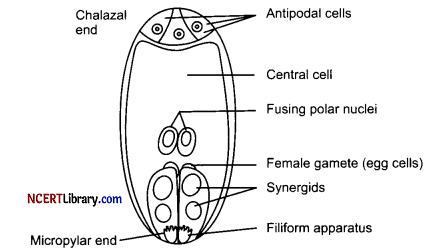
Question 32.
Study the following pedigree chart of a family starting with mother with AB blood group and father with O blood group.
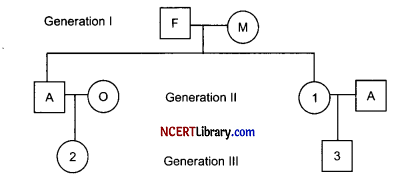
(a) Mention the blood group as well as its genotype of the offsprings numbered 1 in generation II.
(b) Write the possible blood groups as well as their genotypes of the offsprings numbered 2 and 3 in generation III. [5]
OR
Analyse the graph and answer the questions based on it:
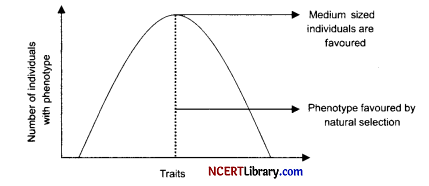
(a) Which principle does the graph represent?
(b) p2 + 2 pq + q2 = 1. Explain this algebraic equation on the basis of Hardy Weinberg’s principle.
(c) With the help of an algebric equation, how did Hardy-Weinberg explain that in a given population the frequency of occurrence of alleles of a gene is supposed to remain the same through generations?
Answer:
(a) The individual numbered as 1 of generation II will have blood group as “B”. The genotype of which will be IB i.
(b) The individual numbered 2 of III generation can have blood group as “A” or “O” with the genotypes IA i., and ii respectively whereas the individual numbered as 3 of the III generation can have the blood group as AB, A or O with the genotype as IA IB, IA i, ii respectively.
The blood group is determined by the presence or absence of one or both the glycoprotein that is group A, B and AB. While the group O has neither of them.
OR
(a) It is Hardy Weinberg’s principle.
(b) If p represents the frequency of allele ‘A’, q represents the frequency of allele ‘a’, then frequency of AA = p2, aa = q2 and Aa = 2p*pTotal genes and their alleles in a population or gene pool remains constant (called as genetic equilibrium). The sum total of all allelic frequencies is:
p + q = 1
(p + q)2 – 1 or p2 + q2 + 2pq =1.
(c) In a population of diploid organisms,
If frequency of allele A = p
and frequency of allele a = q, then the expected genotype frequency under random mating
are:
AA = p2(for AA homozygotes)
Aa = q2 (for aa homozygotes)
Aa = 2pq (for Aa heterozygotes)
In the absence of selection, mutation, genetic drift or other forces, p and q are constant through generations.
Therefore, p2+ 2pq + q2= 133.
![]()
Question 33.
During the course of millions of years of the existence, many species would have evolved a relatively constant internal (within the body) environment that permits all biochemical reactions and physiological functions to proceed with maximal efficiency and thus, enhance the overall ‘fitness’ of the species.
This constancy, for example, could be in terms of optimal temperature and osmotic concentration of body fluids. Ideally then, the organism should try to maintain the constancy of its internal environment despite varying external environmental conditions that tend to upset its homeostasis.
(a) “Organisms may be conformers or regulators.” Explain this statement and give one example of each.
(b) Why are there more conformers than regulators in the animal world?
(c) Why the plants that inhabit a desert are not found in a mangrove? Give reasons. [5]
OR
An ecosystem is a functional unit of nature with constant interaction between living entities and also with their ambient physical environment. An ecosystem differs greatly in many aspects such as its size, from a small lake to a large forest or an ocean.
Since it hugely varies and is complex and big, it is conveniently subdivided into two broad categories such as aquatic(pond, lakes, sea, ocean) and terrestrial(grassland, forest, desert). Some ecosystems are man-made and are referred to as artificial ecosystems.
(a) What is the importance of the ecosystem?
(b) Availability of energy is less for entities at higher trophic levels. Why?
(c) Gan we address an aquarium as a complete ecosystem?
Answer:
(a) Conformers: Organisms which cannot maintain a constant internal environment under varying external environment conditions e.g., all plants, fishes, reptiles, amphibians etc.
Regulators: Organisms which can maintain homeostasis by physiological or behavioural means e.g., birds or mammals etc.
(b) There are more conformers than regulators in the animal world because the process of thermoregulation is energetically not favourable for all organisms.
(c) Desert plants are not adapted to survive in saline or aquatic conditions prevailing in a mangrove. Plants are conformers. They are also stenothermal and cannot maintain constant internal environment.
The osmotic concentration of their body fluids affect the kinetics of enzymes through basal metabolism.
OR
(a) Ecosystem maintains a balance in the environment. It provides fresh air to breathe and sequesters carbon to regulate the climate. It cycles the nutrients through various biogeochemical cycles so that we have access to clean drinking water without any costly methods.
It provides food and shelter to a number of living organisms. It also provides raw materials for different industrial and domestic purposes.
(b) The 10% energy flow law suggested by Lidman, is followed in the ecosystem. As per this law, only 10% of the energy that is available at every trophic level is transferred to the next trophic level.
The remaining is lost in the form of heat(during respiration). As we approach the higher levels, energy keeps declining that is available to entities. Hence the topmost carnivore attains the least amount of energy in a food chain.
(c) An aquarium is an artificial ecosystem made by man. An ecosystem is said to be complete if it possesses all the biological and physical components vital for the survival of fishes. Hence it is a complete ecosystem.